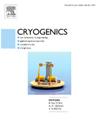Liquefaction and filling of liquid methane and oxygen bipropellant in a common bulkhead tank equipped with a zero boil-off system
Abstract
An experimental setup incorporating a tank with a non-insulated common bulkhead inside and a zero-boil-off system outside was designed and established to investigate the transient thermodynamic characteristics of bipropellant liquid oxygen and methane during liquefaction, filling, and zero-boil-off storage processes. The results demonstrate the advantage of the non-insulated common bulkhead tank in storing liquid oxygen and liquid methane. The non-insulated common bulkhead provided an additional heat transfer pathway, allowing the cold energy released by liquid oxygen to be used to improve the cooling rate of methane and stabilize its storage state during the liquefaction and filling processes. Furthermore, the influence of the operational modes of the zero-boil-off system on the storage states of the fluids was examined. The cooling power delivered by the zero-boil-off system was identified as the most critical factor affecting the storage state of the fluids in the common bulkhead tank. In the absence of cooling power, the temperature rising rates in the liquid oxygen and liquid methane compartments were 4.3 K/h and 4.4 K/h, respectively. Compared with the results during the helium circulator standby stage, the pressure difference between the two compartments increased by 62.73 % in the absence of cooling power. The findings indicate the necessity of maintaining adequate cooling power to achieve stable zero boil-off storage, providing guidelines for the design and operation of practical liquid oxygen-liquid methane common bulkhead storage tanks with zero boil-off requirements.

 求助内容:
求助内容: 应助结果提醒方式:
应助结果提醒方式:


